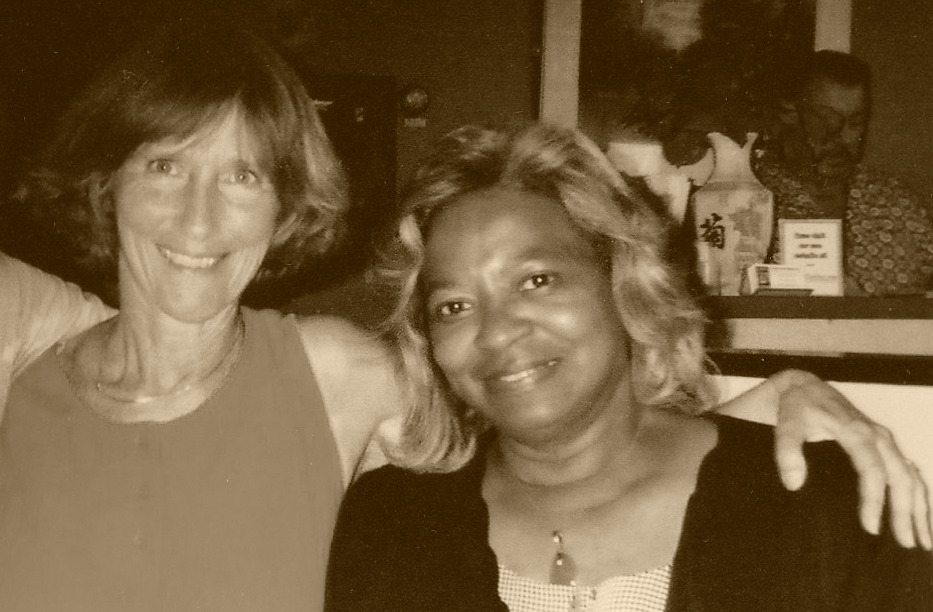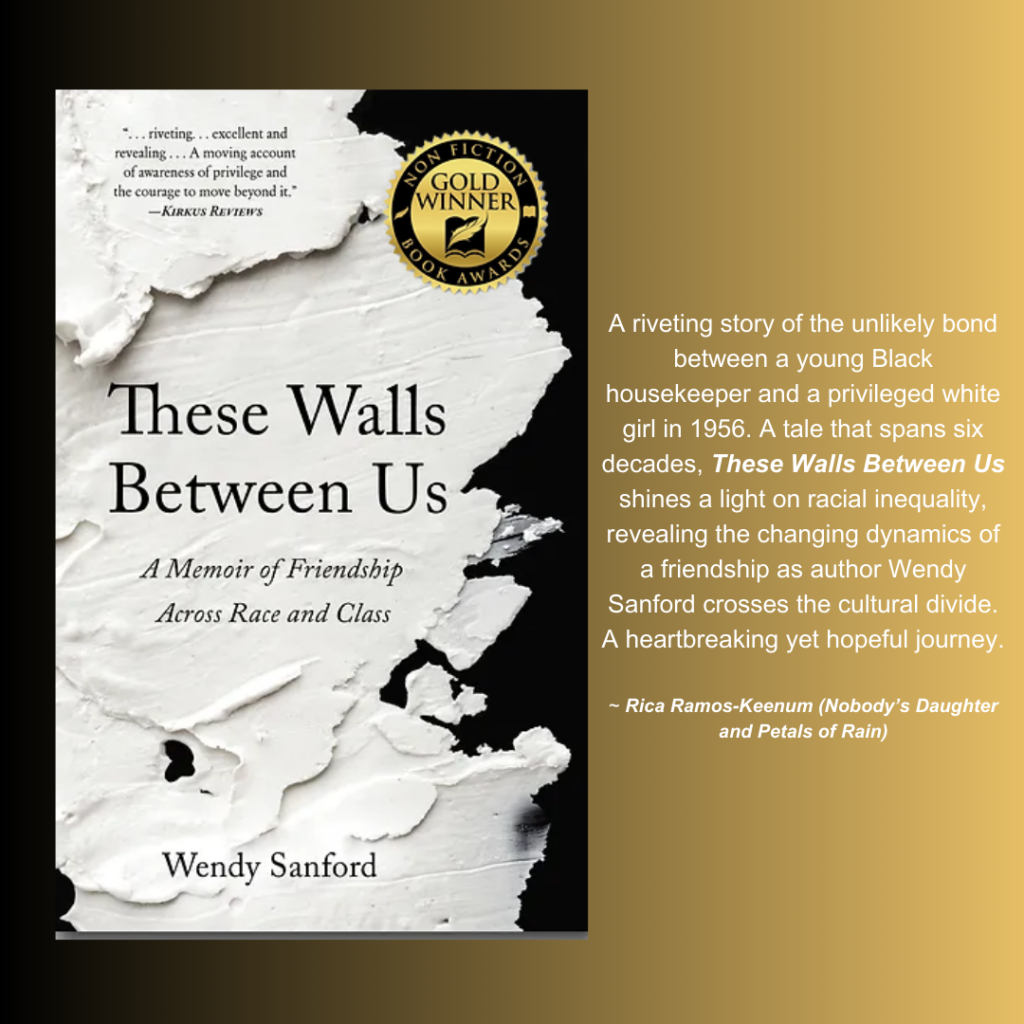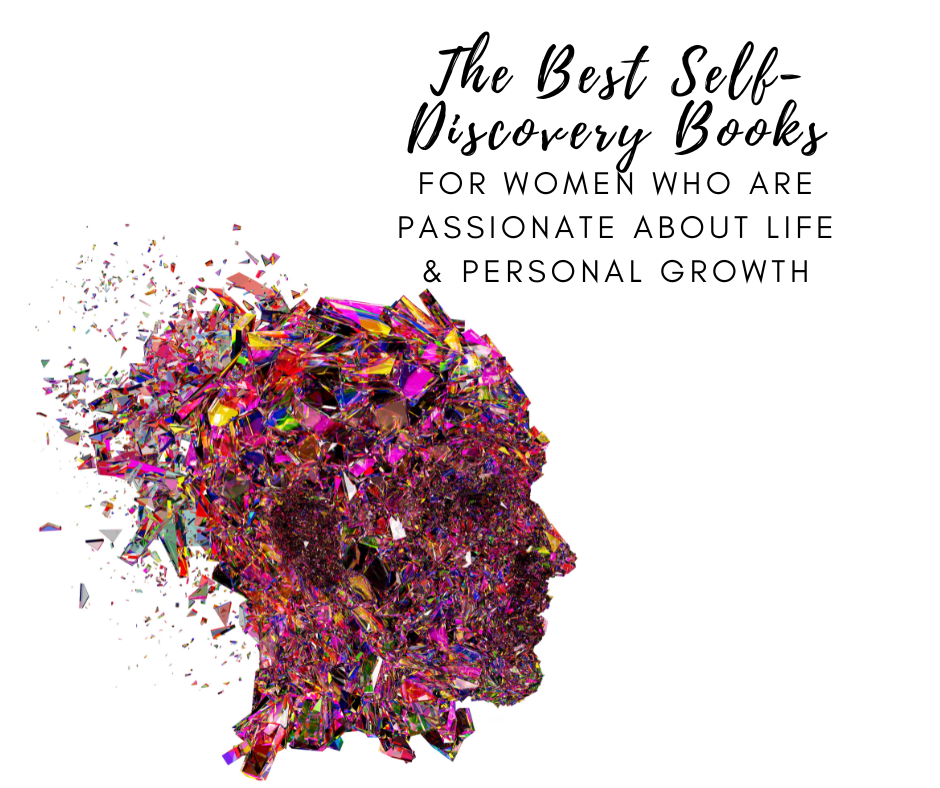
These Walls Between Us: The Bold Story of a Black & White Friendship
Writing a memoir can be emotionally challenging, mentally draining and incredibly time consuming. Those who make it to the finish line often have help along the way–whether it’s a supportive spouse, friend, book coach or the author’s own unswerving passion for the project. As for Wendy Sandford and Mary Norman, it took 30 years to complete their memoir. These Walls Between Us came by way of a spiritual nudge, the compulsion to trust their own hearts and believe in the strength of their message, even when faced with criticism.
In These Walls Between Us, Mary, a 15-year-old Black domestic worker, and Wendy, a 12-year-old privileged white girl, forge a bond that becomes its own footprint on a path riddled with obstacles and racial divides. In this author Q & A, Wendy shares her journey through the memoir, and describes how her need to nurture the friendship with Mary called for a painful exploration of white supremacy culture and honest self-examination. The raw and unflinching story holds the power to transform readers.


These Walls Between Us: From an author of the women’s health classic Our Bodies, Ourselves comes a bracingly forthright memoir about a life-long friendship across racial and class divides. Wendy Sanford, who is white, and Mary Norman, who is Black, have created a sixty-five-year friendship and – at Mary’s suggestion – the award-winning book that mines its riches. Vivid stories lift up the obstacles, in society and in Sanford herself, to this lifelong friendship. Sanford explores her formation in a narrow world of class and race privilege, lifts up the writings and social movements that changed her views and her life, and reveals realities of domestic service rarely acknowledged by white employers. She offers lessons from her oft-stumbling efforts to see Mary Norman more fully and to become a more dependable friend in a context of white supremacy. Now in their eighties, Norman and Sanford have co-created a friendship and a book. Their story sparks conversation and change. A white woman’s necessary learning and a Black woman’s resolute evolution make These Walls Between Us a “tender, honest, cringeworthy and powerful read.” (Debby Irving, author, Waking Up White.)
● What sparked the idea for These Walls Between Us?
When Mary traveled North from rural Virginia as a summer domestic worker for my mother on the island of Nantucket, she was 15 years old, and I was 12. In the context of Mary’s work for my parents over many summers, we had a friendly connection limited by our different positions as Black domestic worker and favored white daughter. Change came in the mid-1980’s, when Mary worked full-time as the first woman to reach officer status in a male corrections facility in Mercer County, New Jersey, and I was active as a feminist and a co-author of Our Bodies, Ourselves. We were both in our forties, both divorced single parents, and both very lonely out there in that vacation enclave for affluent and conservative white people. We began to walk together, after nightfall, on the secluded beach where Mary wasn’t welcome in daytime except in the uniform of domestic service. We began to talk more openly about our lives. Soon, we made time to visit in other seasons. Then Mary had the idea that we should write a book about our friendship. No one would believe it, she said. The story might even get us on Oprah! These Walls Between Us took thirty years to write and became the story of our friendship of 65 years; how we both negotiated the alcoholic family that I grew up in and Mary occasionally worked for; the many missteps that I made in our friendship, as a pretty clueless white person; also Mary’s humane and progressive-minded work in corrections at a time when the tide was turning away from rehabilitation and towards punishment, and her deeply community-based ethic of caring.
● Writing a book is a process with highs and lows. What challenges did you overcome to get your story written, and what tools or practices helped you achieve the goal?
Mary named one of the challenges in creating the book when she said to a book group we Zoomed with recently that, although she suggested we write a book together, she worked two or three jobs at all times through the following decades, and had no time to write. At first, I jumped in to write “our” book on my own, based on conversations between us, but I had to face the fact that, as a white person, I could not actually write “our” book. There was never enough of Mary in it. When we reached the era of smartphones and texting, Mary said, “Ask me anything, and I’ll text you the answer.” Mary’s voice and life experiences entered These Walls Between Us more fully then, and the love that grounds our friendship became more palpable. But the author’s voice is still mine. We decided to aim the book towards well-intentioned white readers who might benefit from my being utterly honest about my missteps and micro-aggressions towards Mary over the years, all I needed to unlearn of white supremacy culture in order see Mary more fully and to become a more reliable friend.
I think the practice that helped me most was what I came to call “restorative reading.” I began to focus more and more on works by Black authors. Their writings increased my understanding of Black American history and culture and of white supremacy culture as well. I think of restorative reading as an ethical practice, allowing me to access crucial information without burdening Black colleagues or friends with my blunt deficits. Restorative reading allows a white reader to become more responsible and accountable in the real world. Restorative reading helped me to become—gradually, awkwardly—a more informed and dependable person in Mary Norman’s life.
Naps are another practice that helped. Writing this memoir was emotional. The honesty I asked of myself was searching. The family scenes I remembered were often painful, as was realizing the ways I hurt Mary during all my clumsy learning. Often, in the middle of a writing session, a nap would take me over. Sleeping replenished my emotional reserves and often sifted my thoughts and feelings into new understandings.
Oh yes, the highs were there, too. The arrival of texting into Mary’s and my co-creation process was one. She had always thought of herself as hating to write. With texting, this changed. A high, for us both I think, was when Mary’s sons read the finished book and encouraged us to go ahead and publish it. I’d had to be prepared for them, or for Mary, to say no.The green light felt wonderful. A recent high has been creating the audio book, with the opportunity to add bonus content in the form of a conversation between Mary and myself about our friendship and our lives. Finally, Mary’s voice is literally present in the book!
● Tell us about the people, places or things that inspire your creativity.
I wrote These Walls under what we Quakers call a “leading,” which is a spiritual nudge towards an action that may seem daunting or impossible but that one is “meant” to tackle. All the times my vision or energy faltered over the thirty years, especially criticism came from people whose judgment I trusted, this “leading” was there in my heart, inspiring me to keep at the project of honoring Mary’s and my friendship and offering its fruits to readers.
● Is there any section chapter or line from your book that you’re most proud of?
I love the chapter about the ways that multi-racial feminism changed me and opened up Mary’s and my friendship. I love the trip we took late in our lives to learn what we could of Mary’s birth father. And I love how our story “lands” in the Epilogue. Here it is:
EXCERPT:
~ These Walls Between Us
Phone Call, November 2020
Mary: We couldn’t have said “friend” at the beginning. It took years to get where we are. If you hadn’t been a curious person, you still wouldn’t know my world. You would just now maybe be trying to figure it out, wondering “what do they want?” If you had been different, we would never have been good friends.
Wendy: If either of us had been different.
Mary:Yes.
What are your next projects, writing or otherwise?
I am such a neophyte at promotion that my main project since publication has been figuring out how to let people know about the book! In a spiritual sense, I guess I’m waiting for “further instructions” about what to write next.

Bio:
Wendy Sanford grew up in a white suburban family in Princeton, New Jersey. During the socially turbulent time of the 1970s, she became a feminist, a lesbian, and a Quaker. A founding member of the Boston Women’s Health Book Collective, Wendy co-authored and edited many versions of the women’s health and sexuality classic, Our Bodies, Ourselves. In her fifties, she began to reckon with her own white skin and the benefits that came to her through being white. Wendy and Polly Attwood, her spouse of forty-four years, are members of Friends Meeting at Cambridge in MA.
Mary Norman grew up in rural southwestern Virginia during the years of Jim Crow threats to the life and wellbeing of African American citizens. She joined the Great Migration, traveling north for work. Mary worked as a part-time domestic worker for affluent white families over several decades. During a long career in corrections, Mary became the first female officer in a male facility in the Mercer County New Jersey correction system, and rose to the rank of Lieutenant. She later mentored several women who, with her support, followed her path to officer status.
These Walls Between Us – Website: Wendy Sanford





